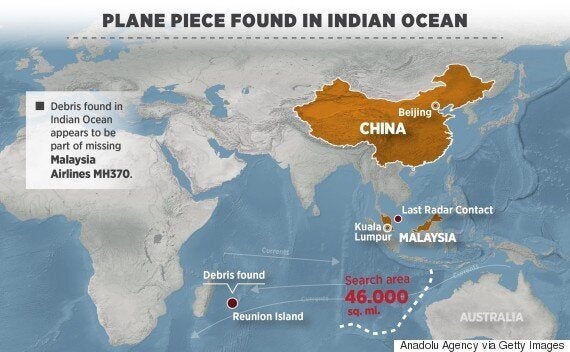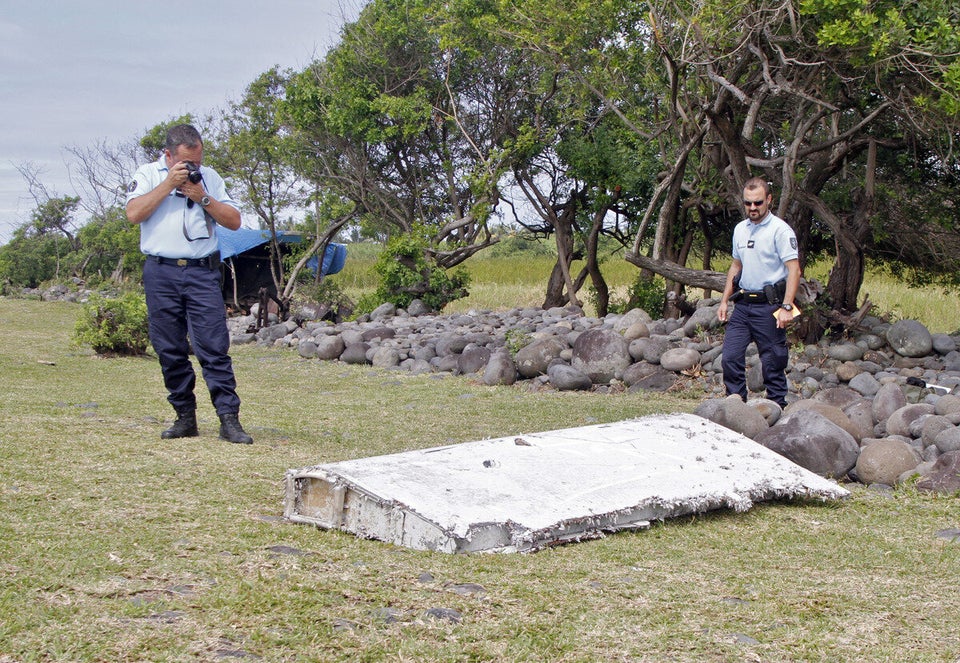Further debris said to be from a plane, including a suitcase, have been found off the coast of the French island of Reunion, as the world waits to see if one of the greatest ever aviation mysteries has finally been solved.
A day after a flaperon from the trailing edge of a Boeing 777 wing - the same aircraft as missing Malaysia Airlines flight MH370 – washed up near the east coast of Africa, images of a battered suitcase have emerged.
It is not yet know if it is related to the discovery of the plane debris, which experts are analysing to see if it belongs to the Malaysia Airlines aircraft which went missing 16 months ago.
The wing piece is about 2 meters (6 feet) long. Investigators have found a number on the part, but it is not a serial or registration number. It could be a maintenance number, which may help investigators determine what plane it belongs to.

Officials collect a piece of plane debris on the French island of Reunion
The Beijing-bound Boeing 777 disappeared from radar with all 239 souls on board on 8 March last year, an hour into its departure from Kuala Lumpur.
Of the flaperon debris, former military pilot Xavier Tytleman told The Telegraph: “I’ve been studying hundreds of photos and speaking to colleagues, and we all think it is likely that the wing is that of a Boeing 777 – the same plane as MH370.
“Police in Reunion examining the wreckage say that it looks like it’s been in the water for about a year, which again would fit with MH370. We can’t say for certainty, but we do think there is a chance that this is it.”
It was well understood after the aircraft disappeared that if there was any floating debris from the plane, Indian Ocean currents would eventually bring it to the east coast of Africa, said aviation safety expert John Goglia, a former member of the US National Transportation Safety Board. But the debris is unlikely to provide much help in tracing the ocean currents back to the location of the main wreckage, he said.
"It's going to be hard to say with any certainty where the source of this was," he said. "It just confirms that the airplane is in the water and hasn't been hijacked to some remote place and is waiting to be used for some other purpose. ... We haven't lost any 777s anywhere else."
Malaysian Deputy Transport Minister Aziz Kaprawi said the debris was "almost certain" to be from a Boeing 777 plane. He said a Malaysian team of at least four experts was leaving Thursday night for Reunion Island to investigate.
"The flaperon is similar to that of a Boeing 777. It will take at least two days to verify," he said.
Story continues below...
"It's the first real evidence that there is a possibility that a part of the aircraft may have been found," said Australian Transport Minister Warren Truss, whose country is leading the search for the plane in a remote patch of ocean far off Australia's west coast. "It's too early to make that judgment, but clearly we are treating this as a major lead."
Flight 370 had been traveling from Kuala Lumpur to Beijing, but investigators believe based on satellite data that the plane turned south into the Indian Ocean after vanishing from radar. If the wing part is from the Malaysia plane, it would bolster that theory and put to rest others that it traveled north, or landed somewhere after being hijacked.
Oceanographer Dr Simon Boxhall of the University of Southampton told BBC Breakfast: “It fits in perfectly. If the plane did indeed go down off the south west coast of Australia then the Western Australian currents will have taken the wing north, it would have then caught up with what we call the southern equatorial current.

Oceanographer Dr Simon Boxhall
“A fast-flowing current would have pushed it towards Madagascar and it would take about 15 to 18 months for any sort of debris at the surface to appear somewhere like Reunion.
“Reunion is a very small island, very remote, but it sort of sits slap bang in the middle of this fast flow."
When asked if he believed further plane parts would be found, he replied: “We would expect it, we were almost waiting for debris to start appearing. The route the debris would have taken goes across a very unpopulated part of the ocean and Reunion is really the first sort of island that these things hit.
"Much of it will appear along the coast of Madagascar, if there is much debris left and then of course it carries on round in a big gyre a big sort of anti-clockwise roundabout and it could spend the next 100 years going around in that gyre. So we would expect to start seeing parts of debris in this area.
Robin Beaman, a marine geologist at Australia's James Cook University, said there is precedence for large objects travelling vast distances across the Indian Ocean. Last year, a man lost his boat off the Western Australia coast after it overturned in rough seas. Eight months later, the boat turned up off the French island of Mayotte, west of Madagascar - 7,400 kilometers (4,600 miles) from where it disappeared.
"I don't think we should rule anything out, that's for sure," Beaman said.

The debris is said to have washed up off Reunion Island, which is off the coast of Madagascar
Beaman believes experts could analyse ocean currents to try to determine where the plane entered the water, though given the time that has elapsed and the vast distance the debris may have travelled, it would be very difficult.
If the part belongs to Flight 370, it could provide valuable clues to investigators trying to figure out what caused the aircraft to vanish in the first place, said Jason Middleton, an aviation professor at the University of New South Wales in Sydney. The nature of the damage to the debris could help indicate whether the plane broke up in the air or when it hit the water, and how violently it did so, he said.
The barnacles attached to the part could also help marine biologists determine roughly how long it has been in the water, he said.
A comprehensive report earlier this year into the plane's disappearance revealed that the battery of the locator beacon for the plane's flight data recorder had expired more than a year before the jet vanished. However, the report said the battery in the locator beacon of the cockpit voice recorder was working.
Investigators hope that if they can locate the two recorders they can get to the bottom of what has become one of aviation's biggest mysteries. The unsuccessful search for Flight 370 has raised concern worldwide about whether airliners should be required to transmit their locations continually via satellite, especially when flying long distances over the ocean.
Over the past 16 months, hopes have repeatedly been raised and then dashed that the plane, or parts of the plane, had been found: Objects spotted on satellite imagery, items found floating in the sea and washed ashore in Western Australia, oil slicks - in the end, none of them were from Flight 370.
The most infamous false lead came in April 2014, when Australian Prime Minister Tony Abbott said officials were "very confident" that a series of underwater signals search crews had picked up were coming from Flight 370's black boxes. The signals proved to be a dead end, with no trace of the devices or the wreckage found.
